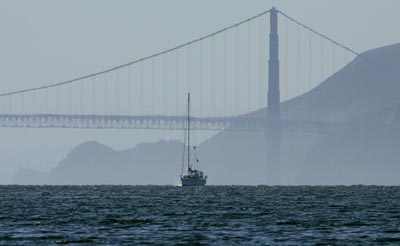
SUDHIN THANAWALA
SAN FRANCISCO
Golden Gate Bridge officials voted overwhelmingly Friday to hang stainless steel nets from the sides of the world-famous span in an effort to stop people from jumping to their deaths.
With a 14-1 vote in favor of the net system, the Golden Gate Transportation District’s board of directors rejected several other options to prevent suicide jumps, including extending the existing 4-foot railings and leaving the iconic bridge unchanged.
Officials said the steel nets, which would hang 20 feet below the bridge and extend about 20 feet from each side, would save lives without marring the California landmark’s appearance.
“I feel the net offers a way to do the most humane and highest-minded thing … in a way that is aesthetically (minimal) as far as impacts on the bridge,” said board member Charles McGlashan.
About 20 people take fatal jumps from the span every year, but 38 jumped last year and 19 have leaped so far this year, according to bridge officials.
The net system, which is expected to cost between $40 and $50 million to build, still requires a final environmental review. It will cost about $100,000 a year to maintain the nets, compared with $500,000 a year in maintenance costs for various suicide barriers, said Mary Currie, spokeswoman for the bridge authority.
Board member James Eddie voted against the plan because he was worried about the cost.
“I want to ensure if we build it, we’re not indebting our children,” he said.
Board member Joanne Sanders said commuters should not pay higher tolls to cover the net system’s expense. She proposed the board consider a pedestrian toll to cover the expense.
Tom Ammiano, a longtime advocate of the barrier on the board, said he has been speaking about funding with state and federal officials, who he said have been supportive of the idea.
Proponents of a suicide barrier applauded after the board’s vote Friday.
John Brooks, 52, whose daughter Caley jumped from the bridge in January, said the barrier was a “moral imperative.”
“There is a good chance that had a barrier been there, she’d still be here,” he said after the vote.
But opponents say a barrier won’t deter people from committing suicide and question whether money would be better spent on mental health treatment.
“We should be able to help these people long before they get to the bridge,” said Mill Valley resident Clark Hinderleider, 62, who spoke against the barrier.









